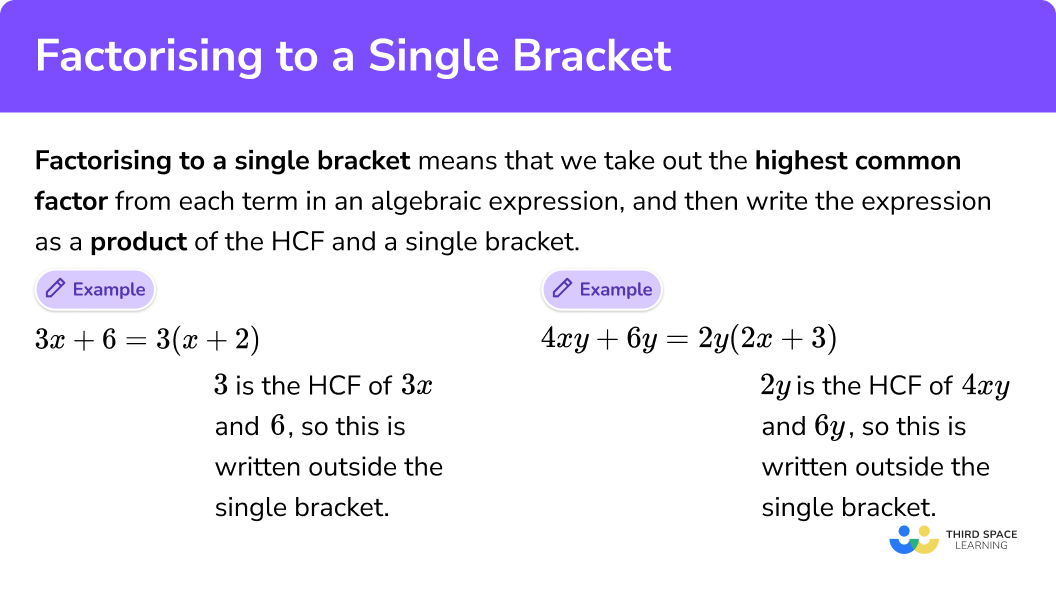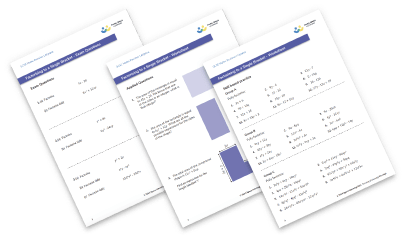GCSE Tutoring Programme
"Our chosen students improved 1.19 of a grade on average - 0.45 more than those who didn't have the tutoring."
In order to access this I need to be confident with:
Expanding brackets Expand and simplify Factors and multiples Powers and roots Algebraic expressions Adding and subtracting negative numbers Multiplying and dividing negative numbers Highest common factor Laws of indices Square numbers and square rootsThis topic is relevant for:

Factorising Single Brackets
Here we will learn about factorising to single brackets by finding the highest common factor.
There are also factorising to single brackets worksheets based on Edexcel, AQA and OCR exam questions, along with further guidance on where to go next if you’re still stuck.
What is factorising single brackets?

How to factorise into single brackets
In order to factorise an algebraic expression into a single bracket:
- Find the highest common factor of each of the terms in the expression.
- Write the highest common factor (HCF) at the front of a single bracket
- Fill in each term in the bracket by multiplying out.
Explain how to factorise into single brackets in 3 steps

Related factorising lessons
We can factorise lots of different types of expressions into single brackets including some quadratics like
For quadratic expressions of the form
Check out our main factorising lesson for a complete summary of all the different ways we can factorise expressions, and then explore our other factorising lessons for detailed step-by-step guides and worksheets on each type.

Factorising single brackets worksheet

Get your free factorising single brackets worksheet of 20+ questions and answers. Includes reasoning and applied questions.
DOWNLOAD FREE
Factorising single brackets worksheet

Get your free factorising single brackets worksheet of 20+ questions and answers. Includes reasoning and applied questions.
DOWNLOAD FREEFactorising single brackets examples
Example 1: variable in just one term
Fully factorise:
1Find the highest common factor (HCF) of the numbers
Factors of 3:
1, 3
Factors of 6:
1, 6
2, 3
Top tip:
Writing the factor pairs makes it easier to list all the factors
The highest common factor (HCF) of
2Write the highest common factor (HCF) at the front of the single bracket.
3Fill in each term in the bracket by multiplying out.
What do I need to multiply
What do I need to multiply
We can check the answer by multiplying out the bracket!
Example 2: variable in just one term
Fully factorise:
Find the highest common factor (HCF) of the numbers 14 and 7.
Factors of 14:
1, 14
2, 7
Factors of 7:
1, 7
The highest common factor (HCF) of
Write the highest common factor (HCF) at the front of the single bracket.
Fill in each term in the bracket by multiplying out.
What do I need to multiply
What do I need to multiply
(don’t forget to keep the – here)
We can check the answer by multiplying out the bracket!
Example 3: variable in two terms
Fully factorise:
Find the highest common factor (HCF) of the numbers 8 and 12.
Factors of 8:
1, 8
2, 4
Factors of 12:
1, 12
2, 6
3, 4
Find the highest common factor (HCF) of the variables
The highest common factor (HCF) of
Write the highest common factor (HCF) at the front of the single bracket.
Fill in each term in the bracket by multiplying out.
What do I need to multiply
What do I need to multiply
We can check the answer by multiplying out the bracket!
Example 4: variable in two terms
Fully factorise:
Find the highest common factor (HCF) of the numbers 15 and 10.
Factors of 15:
1, 15
3, 5
Factors of 10:
1, 10
2, 5
Find the highest common factor (HCF) of the letters
The highest common factor (HCF) of
Write the highest common factor (HCF) at the front of the single bracket.
Fill in each term in the bracket by multiplying out.
What do I need to multiply
What do I need to multiply
We can check the answer by multiplying out the bracket!
Example 5: variable in two out of three terms
Fully factorise:
Find the highest common factor (HCF) of the numbers 6, 2 and 12
Factors of 6:
1, 6
2, 3
Factors of 2:
1, 2
Factors of 12:
1, 12
2, 6
3,4
The highest common factor (HCF) of
Write the highest common factor (HCF) at the front of the single bracket.
Fill in each term in the bracket by multiplying out.
What do I need to multiply
What do I need to multiply
What do I need to multiply
Don’t forget to keep the – here!
We can check the answer by multiplying out the bracket!
Example 6: variable in two out of three terms
Fully factorise:
Find the highest common factor (HCF) of the numbers 12, 4 and 8
Factors of 12:
1, 12
2, 6
3,4
Factors of 4:
1, 4
2, 2
Factors of 8:
1, 8
2, 4
Find the highest common factor (HCF) of the letters
The highest common factor (HCF) of
Write the highest common factor (HCF) at the front of the single bracket.
Fill in each term in the bracket by multiplying out.
What do I need to multiply
What do I need to multiply
What do I need to multiply
Don’t forget to keep the – here!
We can check the answer by multiplying out the bracket!
Common misconceptions
These are some of the common misconceptions around factorising into single brackets
- We must fully factorise
12x2 – 6x = 2(6x2 – 3x)
Here we have factorised the expression, however it is not fully factorised because 2 is not the highest common factor.6x is the highest common factor, so this is the correct final answer:12x2 – 6x = 6x(2x – 1) 12x2 – 6x
Even though this a quadratic expression we still factorise it to give a single bracket because it is not in the formax2 + bx + c
Practice factorising single brackets questions
1. Fully factorise: 5x+10
5(x+10)

5x(x+2)

5(x+2)

x(5+10)

The highest common factor of 5 and 10 is 5 . We can divide each term in the original expression by 5 , which means the bracket must contain (x+2) .
2. Fully factorise: 8-2y




The highest common factor of 8 and 2 is 2 . We can divide each term in the original expression by 2 ; the bracket must contain a minus sign just like the original expression.
3. Fully factorise: 18x^{2}-12x
3x(6x-4)

6(3x^{2}-2x)

3(6x^{2}-4x)

6x(3x-2)

The highest common factor of 18x^{2} and 12x is 6x . We can divide each term by 6x , which means the bracket must contain (3x-2) .
4. Fully factorise: 20y^{2}+16xy
4y(5y-4x)

y(20y-16x)

2y(10y-8x)

4xy(5y-4x)

The highest common factor of 20y^{2} and 16xy is 4y . We can divide each term by 4y , which means the bracket must contain (5y-4x) .
5. Fully factorise: 18-6y+15x
3xy(6-2y+5x)

3(6-2y+5x)

18(1-2y+5x)

3(6+2y+5x)

The highest common factor of 18,6y and 15x is 3 . We can divide each term by 3 , which means the bracket must contain (6-2y+5x) .
6. Fully factorise: 12y-9x^{2}y+6y^{2}
12y(1-3x^{2}+2y)

3y(4+3x^{2}+2y)

3y(4-3x^{2}+2y)

3y(4-3x^{2}-2y)

The highest common factor of 12y, 9x^{2}y and 6y^{2} is 3y . We can divide each term by 3y , which means the bracket must contain (4-3x^{2}+2y) .
Factorising single brackets GCSE questions
1. Factorise: 5x-20
5(x-4)
(1 mark)
2. Factorise fully: 8x2 + 12xy
4x(2x+3y)
(2 marks)
3. Factorise: x2 + 8x
x(x+8)
(1 mark)
Learning checklist
- Manipulate algebraic expressions by taking out common factors to factorise into a single bracket
Factorise quadratic expressions of the form x2 + bx + cFactorise quadratic expressions of the form of the difference of two squaresFactorising quadratic expressions of the form ax2 + bx + c (H)
The next lessons are
Still stuck?
Prepare your KS4 students for maths GCSEs success with Third Space Learning. Weekly online one to one GCSE maths revision lessons delivered by expert maths tutors.

Find out more about our GCSE maths tuition programme.